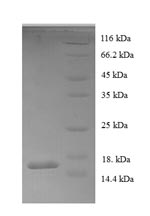The expression region of this recombinant Human DBI covers amino acids 2-104. The theoretical molecular weight of the DBI protein is 15.7 kDa. The DBI protein was expressed in e.coli. The DBI gene fragment has been modified by fusing the N-terminal 6xHis tag, providing convenience in detecting and purifying the recombinant DBI protein during the following stages.
The human acyl-CoA-binding protein, also known as diazepam-binding inhibitor (DBI), is a multifunctional protein primarily located in the mitochondrial matrix. Its primary role is to bind and transport long-chain fatty acyl-CoA esters, participating in lipid metabolism and cellular energy regulation. Additionally, DBI is involved in the modulation of GABAergic neurotransmission as a neuropeptide, contributing to the regulation of neuronal activity and behavior. DBI's diverse functions extend to the regulation of steroidogenesis, cellular differentiation, and apoptosis. The intricate involvement of DBI in various cellular processes makes it a key player in maintaining metabolic and neural homeostasis, with potential implications in metabolic disorders and neurological conditions.






